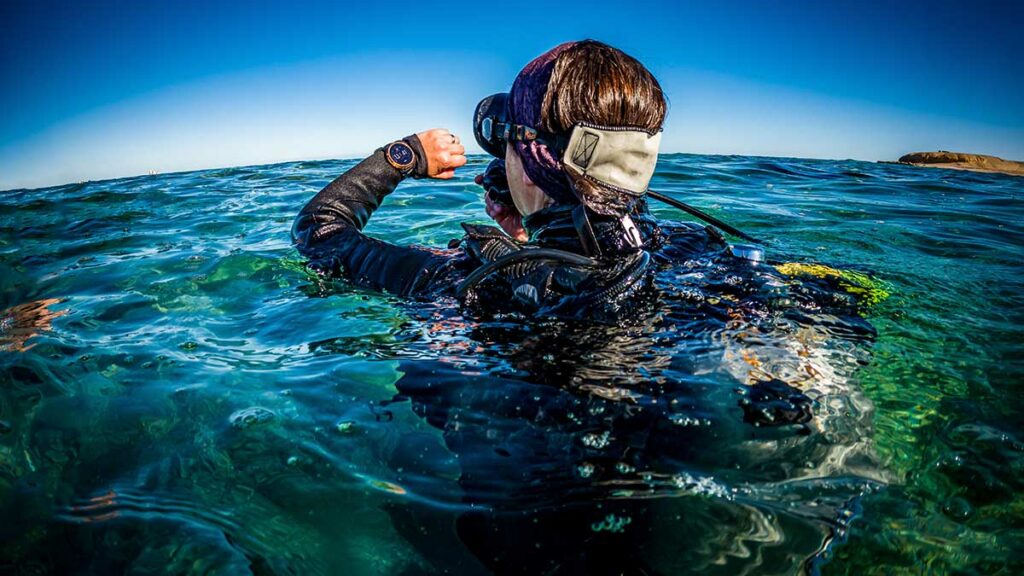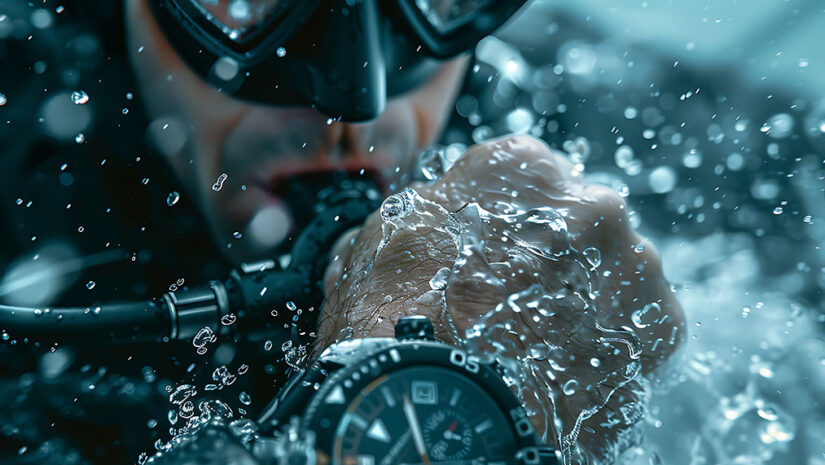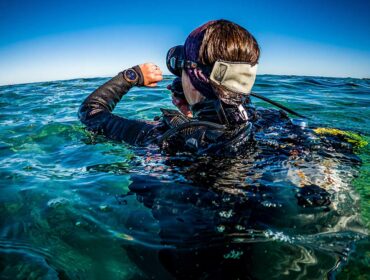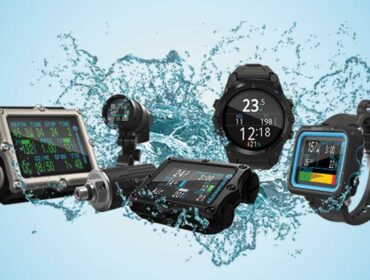In the diving world, whether you are just starting your journey or just looking to improve your dives, dive computers in 2024 are essential. A dive computer stores important information and keeps your dive safe. There’s a scuba dive computer for every diver, so when you are in the market for one, consider your diving needs and habits.
Are you a tip-top shape diver? A conservative diver? A long-hours-and-multiple-dives-in-one-day diver? All of these variables will determine what kind of gear you will need.

What is a dive computer?
A dive computer is a sophisticated electronic device used by divers to enhance safety and optimize dive planning. It tracks essential data such as depth, time underwater, and nitrogen levels in real-time, helping divers avoid decompression sickness by calculating safe ascent profiles. Additionally, it offers features like no-decompression limit tracking, dive log storage, and alarms for critical events. By providing instant and accurate information, a scuba diving computer enables divers to make informed decisions during their underwater adventures, making diving safer and more enjoyable.
A basic and primary feature of all dive computers is the fact that they measure depth. Its measurement of depth is a lot more accurate than an average analog depth gauge. Based on your dive’s duration and depths, a dive computer calculates how many decompression stops you need to make and at what depths. It also calculates the surface interval time you need to spend between dives and also calculates when it is safe to fly after diving. These are all important for divers who rely on air travel at the end if their diving vacations.
Dive Computer Styles
There are essentially two types or styles of dive computers available: wrist or watch style, and console or module dive computers.
Wrist-Mounted Dive Computers
The more popular choice among recreational divers today, mainly for their convenience, wrist dive computers as the name implies are worn on the wrist by the diver and look like large-faced watches. An advantage this style of dive computer has over the console-mounted style is that as it’s not connected to your other gear. It’s more versatile to be used with any scuba kit. Some examples are:
Console Dive Computers
The console dive computer is a slightly more economical option. It is attached to other scuba gear via a hose and typically come with a pressure gauge, unlike the most wrist mounted options (excluding air-integrated wrist computers). The advantage of this style is that the it is sometimes easier to read as the display is fairly large.
Best Dive Computers
Best for Beginners: Mares Puck Pro Wrist Computer
Why we chose it
The Mares Puck Pro Wrist Computer offers advanced features without overwhelming new divers with unnecessary complexity.
Key features
- Full featured RGBM NITROX computer
- Air, nitrox and BT function modes
- 36 hours memory capacity
- Smart, easy, and intuitive to use
- Two different gas mixtures during single dive
Overview
Its sleek, watch-like design and clear, high-resolution display make it easy to read underwater. The single-button interface allows for intuitive navigation through its three modes: Air, Nitrox, and Bottom Timer. The long battery life and user-replaceable battery ensure that maintenance is minimal.
Additionally, the ability to update firmware via USB interface and integrate with PC or Mac software makes it a versatile and future-proof choice for divers who are just starting out and want a reliable, easy-to-use dive computer.
Best for Diving & Sport: Suunto Ocean Wrist Computer with Tank POD Transmitter
Why we chose it
Its bright, colorful display and durable exterior ensure it can withstand the rigors of both underwater adventures and high-intensity sports.
Key features
- Computer: Dive-Smart Technology
- Computer: Waterproof to 100m
- Computer: 40-Hour Battery
- Transmitter: Quick and easy view of tank pressure
- Transmitter: Blinking Green Light shows pairing and data transmission
Overview
The Suunto Ocean Wrist Computer with Tank POD Transmitter is ideal for active individuals who want a versatile device that can handle both diving and everyday sports activities.
The watch’s ability to track various activities and provide insights into your fitness levels helps you balance your diving with your daily life. The Tank POD Transmitter adds convenience by wirelessly displaying tank pressure, eliminating the need for a traditional pressure gauge.
The combination of features found in the Suunto Ocean Wrist Computer makes it perfect for divers who lead active lifestyles and need a reliable, multi-functional watch.
Best All-Around Computer: Garmin Descent Mk3i Dive Computer
Why we chose it
Its dive-first design, combined with multi-band GPS technology and a high-definition AMOLED display, ensures one has the most accurate and clear information during dives.
Key features
- Dive computer with a 1.2″ AMOLED display, scratch-resistant sapphire lens and steel bezel
- Dive-first design with 200-meter dive-rated case includes metal leakproof inductive buttons and multiple dive modes
- Enhanced SubWave sonar technology provides the ability to exchange preset diver-to-diver messages up to 30 meters
- Dive readiness tool factors sleep, exercise, stress and jet lag to assess body’s overall preparedness for diving
- DiveView maps offer bathymetric depth contours and more than 4,000 dive sites
- Multi-band GPS technology enhances positional accuracy while youfre out on the water
- Dive logs automatically sync with the Garmin Dive app downloaded to your compatible smartphone
- Battery performance: up to 10 days in smartwatch mode and up to 30 hours in dive mode
Overview
The Descent Mk3i is designed for tech-savvy divers who appreciate advanced features and a stylish design. Why? Well, for one: its SubWave sonar technology allows for diver-to-diver communication, enhancing safety and coordination underwater. Its strong construction, scratch-resistant sapphire lens, and titanium bezel just screams: “I will survive in harsh conditions!”
The integration with the Garmin Dive app allows for seamless syncing of dive logs and fitness tracking, making it a comprehensive tool for divers who value cutting-edge technology and comprehensive functionality.
Best Compact Tech Computer: Shearwater Teric Dive Computer
Why we chose it
Its bright and high-res AMOLED screen and intuitive controls give off major tech vibes – exactly what the modern-day scuba diver needs.
Key features
- Teric Dive Computer: Decompression Computer
- Teric Dive Computer: Air Integrated
- Swift AI Transmitter: LED status indicator
- Swift AI Transmitter: Easy ‘no tools’ installation and removal on divers first stage
Overview
The Shearwater Teric Dive Computer (with Swift Transmitter Combo) is designed for both beginners and advanced technical divers who want a high degree of customization and advanced features.
The Teric offers multiple diving modes, including recreational, technical, and freediving, making it a versatile choice that can grow with the diver’s skills. The Swift Transmitter provides reliable air integration, allowing for real-time gas pressure data.
The wireless charging, Bluetooth connectivity, and customizable display make it a powerful, future-proof choice for divers seeking a high-performance dive computer.
Best Budget Dive Computer: Cressi Leonardo
Why we chose it
The Cressi Leonardo Dive Computer’s single-button interface plus its various modes including Air, Nitrox, Gauge, and Freediving.
Key features
- Budget-friendly option for cost-conscious divers
- Underwater & Freediving Computer
- Ideal for Other Water Activities
- Depth Rating: 492 (150m)12/24 Clock Format w/Calendar
- High-Power Backlit Display
- Low Battery IconFreediving (apnea) Mode
- Air or Nitrox w/PPO2 1.2-1.6 Configuration
Overview
The Cressi Donatello Wrist Computer is tailored for divers who want a straightforward, functional, and reliable dive computer.
The large, clear displays ensure easy readability underwater, and the power-saving processor along with a user-replaceable battery ensures longevity and minimal maintenance. The distinct audible alarms and visible battery life indicator add to its reliability, making it a great choice for both new and experienced divers who prefer a no-nonsense, easy-to-use dive computer.
Best Tech Dive Computer: Shearwater Perdix 2 Ti Dive Computer
Why we chose it
Its high-resolution display, customizable layout, and strong vibration warning alerts ensure critical information is easily accessible.
Key features
- User replaceable AA battery
- Air, nitrox, trimix capable
- Buhlmann GF algorithm
- Strong vibration warning alerts
Overview
The Shearwater Perdix 2 Ti Dive Computer is designed for serious recreational and technical divers who require advanced features and top-notch construction.
The Perdix 2 supports air, nitrox, and trimix, making it suitable for various diving styles. Its impact-resistant glass screen and titanium casing ensure durability.
The Bluetooth wireless tech and user-replaceable batteries add convenience, making it a reliable and powerful choice for advanced divers who need a highly capable and versatile dive computer.
Best New Dive Computer: Shearwater Peregrine TX Wrist Dive Computer with Smart AI Transmitter
Why we chose it
The Shearwater Peregrine TX Wrist Dive Computer has a large and full-color range display. You can see everything!
Key features
- Dive Computer: Rated for depths up to 120m
- Dive Computer: Compatible with three types of gas mixes
- Dive Computer: Includes Bluetooth technology for connectivity
- Smart AI Transmitter: Dive with next-gen tech intelligence
- Smart AI Transmitter: Dive without dropped communications
Overview
The Shearwater Peregrine TX Wrist Dive Computer + Smart AI Transmitter is designed for sport divers who want a user-friendly interface combined with advanced features.
The air integration capability with the Smart AI Transmitter provides real-time gas pressure data, enhancing safety and dive time management. The Peregrine TX also features a digital compass and sidemount air integration, making it versatile for different diving scenarios.
The wireless rechargeable battery and compatibility with multiple languages exist for a scuba diver’s convenience, making it a great choice for sport divers who want a reliable and feature-rich dive computer.

What to Look for in a Dive Computer
Selecting the right scuba dive computer is essential for a safe and enjoyable underwater experience. Several key factors should be considered to ensure you make an informed choice:
Interface
The first thing you’ll need to ensure is that the computer has a user-friendly interface, especially if you’re a beginner. It doesn’t have to be incredibly plain, as long as the elements on the display are arranged in a way that you can easily understand at first glance. Of course, you also have to make sure that it is easy to read even in darker environments, which is usually the case underwater, so choose one that has good backlighting.
Dive Modes and Gas Compatibility
Choose a dive computer that supports the dive modes you intend to use, whether it’s recreational, nitrox, trimix, or rebreather diving. Ensure it’s compatible with the gases you plan to use during your dives.
Algorithm
The dive computer’s algorithm is crucial for calculating decompression limits, ascent rates, and other critical data. Look for a well-established algorithm that has been tested and proven to enhance diver safety.
Ease of Use
User-friendly interfaces and intuitive menus are vital, especially for beginners. Navigating through settings and accessing dive information should be straightforward.
Audible and Visual Alarms
Alarms for depth, ascent rate, decompression limits, and other important alerts are crucial for safety. Ensure the dive computer offers both audible and visual alarms.
Battery Life
It helps to get a dive computer that has the capability to warn the diver about low-battery life, so they can replace it before starting a dive. This will ensure that your dive computer has more than enough power to continuously calculate changes in the dissolving nitrogen in your body.
Also, make sure to check if the battery on your dive computer can be easily changed without the assistance of a technician. Older models may need to be serviced before dives to ensure that the battery will be able to function well throughout the next dive.
Size and Comfort
The size and fit of the dive computer should be comfortable on your wrist. Bulkier models might not be ideal for everyday wear.
Wireless Air Integration
This feature allows you to monitor tank pressure directly on your dive computer. It’s a convenient way to keep track of your air supply.
Durability
Look for a dive computer built to withstand the underwater environment. Rugged construction ensures it can handle the pressures and potential knocks of diving.
Logbook and Connectivity
A comprehensive logbook feature stores your dive history, aiding in post-dive analysis. Some dive computers can be connected to your laptop or PC to allow you to export your dive data. Serious divers often consider this an important feature as it helps them obtain detailed dive information and keep them organized in a digital dive log.
Price
Set a budget and find a dive computer that meets your needs within that range. Remember, safety is paramount, so consider it an investment in your well-being.
Future Growth
Consider your diving goals. If you’re planning to advance your diving skills, look for a dive computer that can accommodate your future needs.

Dive Computers: Frequently Asked Questions
Dive computers typically require servicing every 1 to 2 years, depending on the manufacturer’s recommendations, usage frequency, and environmental conditions. Regular servicing ensures accurate readings, extends the device’s lifespan, and enhances safety during dives.
A well-maintained dive computer can last anywhere from 5 to 10 years or more, depending on usage frequency, and how well it’s cared for. Regular maintenance, battery changes, and following manufacturer recommendations contribute to its longevity.
The cost of a dive computer varies based on features, brand, and intended use. Entry-level models start around $150, while mid-range options range from $300 to $600. High-end dive computers, packed with advanced features, can cost $1,000 or more. Choose one that suits your diving needs and budget.
Conclusion
In the realm of underwater exploration, the right dive computer can make all the difference. As we’ve delved into the features and capabilities of some of the best dive computers on the market, it becomes clear that choosing the ideal one hinges on factors such as your diving style, experience level, and budget. Whether you’re a novice seeking simplicity, a technical diver aiming for precision, or an adventurer seeking the latest innovations, the wide array of options caters to diverse preferences. Ultimately, the best dive computer is the one that aligns seamlessly with your underwater aspirations, ensuring safety, efficiency, and an enhanced connection to the aquatic world.





